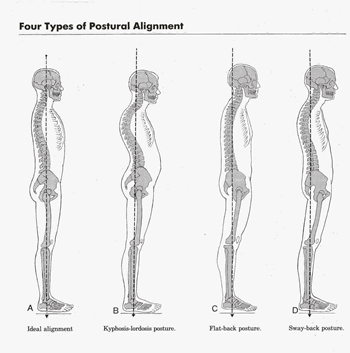 You may not be as fat as you think you are. No, seriously, and I'm not talking about body dysmorphia, although that is another important topic. No, this time I am talking about how the anterior posterior curves of your spine and the tilt of you pelvis can affect how prominent your abdomen is. This is a subject dear to my heart...well, my tummy. Just as the spine can develop lateral curves (scoliosis), so the anterior posterior curves can vary also and just as a scoliosis can be due to bony architecture and permanent (to a greater or lesser degree) or can be due to temporary or recent soft tissue changes and can be more amenable to change so can anterior posterior curves.  There are several different categorisations of different back shapes, this is the one I was taught...I admit I objected to the terminology 'ideal'...because mine isn't preferring the term 'ordinary' with the slight implied dullness, but the truth is 'ideal' is ideal for weightbearing and good function of the body. If you look at kypho-lordotic you will see that even in these diagrams it is drawn with a protruding tummy. It is actually very hard to arch the small of your back without sticking your tummy out. If you ask a child to stick their tummy out they will do just that. Not only does the kypjo-lordotic posture push out the tummy it rounds the back which naturally encourages the shoulders to round in from the sides (so you have round shoulders) and makes you crane your neck which can cause problems there, so all in all, not ideal, however dull that may be. So can anything be done about this? The short answer is yes. How much change can be effected depends on what is causing the posture, how much time, effort and resource you are willing to commit and how adaptable your body is. Sometimes the problem is very acute and has occurred because of a recent injury perhaps a minor facet joint or rib lesion injury that is bending over your upper back (kyphosis) and causing you to arch the lower back to bring our head up level, sometimes the hip flexors (especially psoas), or muscles in the low back are too tight, maybe due to over training or poor training, and are pulling the low back into extension, or indeed there could be a minor joint injury in the low back or even the pelvis. These problems are usually easily resolved with treatment. Sometimes the problem is due to poor habits and soft tissues in general have shortened in these positions, these the patients may have to commit to a longer period of treatment and/or changed behaviours and stretching/exercise routines. For some, there may be bony changes, wedging of vertebrae. This is common in the elderly, but also (usually in a minor way) in teenagers who especially those who grow very quickly. For these patients we would expect a smaller margin of improvement, the possibilities are limited but gravity will be constantly trying to increase the curve so there is likely to be room for improvement. More importantly internal organs from the lungs to the digestive system (reflux etc) to the bladder are strongly affected in their roles by changes in posture and the pressures that exerts...a small change may make a big difference to quality of life. I mentioned this being important to me. I think I always had a tendency to push out my belly and I've had a niggling injury that causes my upper back to be more rounded than I'd like. So I have been receiving osteopathic treatment and exercising to try and reduce my kypho-lordotic posture. I know it is working because I haven't lost weight but now some of my trousers that were tight are loose and shirts that didn't fasten now do comfortably. For me some of my belly was definitely from my back...for Mr Greedy I am not so sure
1 Comment
|
Archives
February 2024
AuthorDamian is the principal osteopath at Vauxhall Village Osteopathy and Oval Osteopathy Categories
All
|


 RSS Feed
RSS Feed


